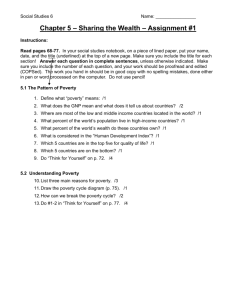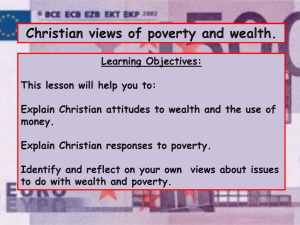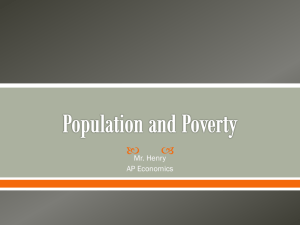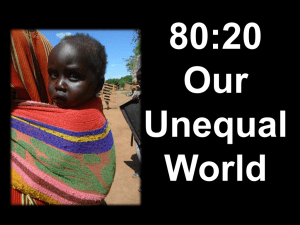IFS Financial resources & well-being Carl Emmerson & Ali Muriel
advertisement
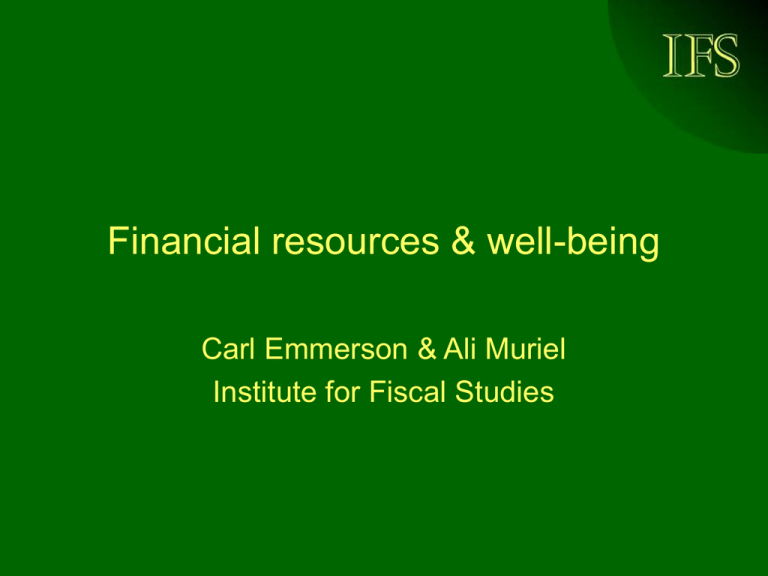
IFS Financial resources & well-being Carl Emmerson & Ali Muriel Institute for Fiscal Studies Outline Income poverty • Income poverty rates & persistence • What is correlated with income poverty? • Transitions into/out of income poverty Wealth over the life cycle • Growth in wealth from Wave 1 to Wave 3 – Did beneficiaries of housing boom ‘run down’ other sources of wealth? • What fraction have wealth in excess of Inheritance Tax threshold? – Is this fraction declining with age? © Institute for Fiscal Studies, 2008 Measurement Income/poverty • ‘Family’ (benefit unit) income from all sources • Net of taxes and benefits • Poverty line – 60% of UK median family income Wealth • Includes financial, physical and housing wealth • Net of any mortgage debt • Excludes wealth held in state and private pensions © Institute for Fiscal Studies, 2008 IFS Income Poverty Poverty Rates in ELSA Poverty Line: £120.94 £129.66 £139.44 35% 30% 25% 20% 15% 10% 5% 0% 2002/03 All ELSA © Institute for Fiscal Studies, 2008 2004/05 Fifty to SPA 2006/07 SPA plus Factors associated with income poverty (2002/03) – family type 0% In couple Men Women Never married Men Women Divorced/ separated/ widowed Men Women © Institute for Fiscal Studies, 2008 2% 4% 6% 8% 10% 12% 14% 16% 18% 20% Factors associated with income poverty Labour market status – Substantially higher risk of income poverty if you/your partner not in labour force Above State Pension Age – Lower risk of income poverty (controlling for other factors) Education – Graduates face lowest risk of income poverty © Institute for Fiscal Studies, 2008 Persistence of Poverty 60% 50% 40% 30% 20% 10% 0% Wave 1 - 2 All ELSA © Institute for Fiscal Studies, 2008 Wave 2 - 3 Fifty to SPA All 3 Waves SPA plus Transitions into/out of income poverty -20% -18% -16% -14% -12% -10% -8% -6% -4% -2% 0% In couple Men Women Never married Men Women Divorced/ separated/widowed Men Women Into Poverty © Institute for Fiscal Studies, 2008 Out of Poverty 2% 4% 6% 8% 10% 12% 14% Transitions into/out of income poverty Labour market status – Moving into labour force associated with increased probability of leaving poverty (18ppt) – Moving out of labour force probability of entering poverty (21ppt) Reaching State Pension Age – Associated with increased chance of leaving poverty (17ppt) © Institute for Fiscal Studies, 2008 Income poverty - summary Trends: • Fell between 2002-03 and 2004-05 • ... but unchanged between 2004-05 and 2006-07 • Divorced, separated and widowed women at greatest risk Persistence: • More than half of pensioners in income poverty in one ELSA wave are still in poverty in the next wave Transitions: • Losing partner & leaving work associated with significantly higher risk of entering poverty • Reaching SPA reduces risk of entering poverty, increases chances of leaving poverty © Institute for Fiscal Studies, 2008 IFS Wealth Total wealth by age 300,000 2002-03 median 2004-05 median 2006-07 median Total wealth (£) 250,000 200,000 150,000 100,000 50,000 0 50 52 54 56 58 60 62 64 66 68 70 72 74 76 78 80 Age © Institute for Fiscal Studies, 2008 Wealth changes, wave 1 to wave 3 0.8% Total wealth 0.7% Non-housing wealth Density 0.6% Non-housing wealth among those with housing 0.5% 0.4% 0.3% 0.2% 0.1% 0.0% -200 © Institute for Fiscal Studies, 2008 -100 0 100 200 300 Percentage change 400 500 600 Wealth change, wave 1 to wave 3, by age Total wealth Non-housing wealth Median change in wealth (%) 60 50 40 30 20 10 0 -10 -20 -30 50 52 54 56 58 60 62 64 Age © Institute for Fiscal Studies, 2008 66 68 70 72 74 76 78 Inheritance Tax • Fraction of estates paying Inheritance Tax (from administrative data): – 2.3% in 1996–97 – 5.9% in 2005–06 • Yet 11.8% of individuals aged 50+ in ELSA have total wealth above Inheritance Tax Threshold • Are individuals running down their wealth as they approach the end of their lives? © Institute for Fiscal Studies, 2008 Total wealth in excess of the Inheritance Tax threshold (panel) Wealth above inheritance tax threshold (%) 16% 14% 12% 10% 8% 6% 4% 2% 0% 50 52 54 56 58 60 62 64 Age © Institute for Fiscal Studies, 2008 66 68 70 72 74 76 78 Wealth - summary • Wealth distribution shifted strongly upwards between Wave 1 & Wave 2 – Less movement between Waves 2 & 3 • Total wealth growing strongly (on average) between Wave 1 and Wave 3 • Non-housing wealth little changed (on average) – Not falling for those with housing wealth • Little sign of age profile in wealth accumulation • Fraction with wealth above IHT threshold appears to be climbing with age – However, housing market declines may reverse this pattern © Institute for Fiscal Studies, 2008 IFS Financial resources & well-being Carl Emmerson & Ali Muriel Institute for Fiscal Studies
